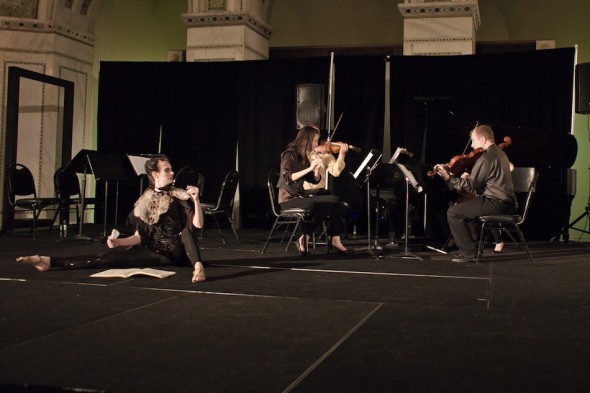Chicago Classical Review
A strange, compelling musical tale weaved by Fifth House EnsembleWynne Delacoma
One of the most memorable productions of last year’s music season was Fifth House Ensemble’s Black Violet. A set of three concerts that mixed emotionally charged chamber music with elegantly austere graphic novel images, it told the tale of a pampered house cat trying to survive in London during the 17th century’s catastrophic Black Plague.
The young, gifted musicians of Fifth House are back this week with something equally unusual, the first installment of another three-part project, The Weaver’s Tale. The first segment, titled The Weaver’s Tale: of the Fearless Boy and the Loveless Girl, was performed Tuesday at the Chicago Cultural Center’s Preston Bradley Hall.
The basic format is the same as that of Black Violet, but this time the action involved four live actors rather than projected images. Throughout the evening the musicians came and go as quintets and quartets to perform single movements of chamber works by various composers as background music for the actors who spoke no lines. The score included selected movements from David Maslanka’s Wind Quintet No. 2 and Mark Fish’s Pictures of Miro as well as the complete Red River, a quartet by Mason Bates, and the C Minor Piano Quintet by Ralph Vaughan Williams.
Co-written and directed by Rebekah Scallet and Lindsey Marks, the evening mixed two fairy tales–the beloved Russian story about a beautiful snow maiden who eventually melts, breaking the heart of her beloved, and the Grimm fairy tale about a boy who must learn fear.
This could have been unbearably precious, an attempt to liven up a static chamber music performance with some mimed story-telling. But the result was a seamless, oddly compelling drama. As the Weaver, the spider who spins the tale, Lindsey Marks darted and lunged, a witty figure whose long, skinny limbs folded and reached like the black widow’s hinged legs. Bethany Hedden was sweetly curious as the Loveless Girl, and Stephen Ochsner had the acrobatic grace and guileless smile of a tall, lanky schoolboy. Gilliam Weston was powerful as the stern figure who kept the young lovers apart.
The musicians, who also offered short spoken narration as the story unfolded, played with a fervor that seemed to sweep the actors along. They relaxed easily into the romantic lyricism of Williams’ Piano Quintet but bristled with high-voltage color and drive in the short, repeated phrases of Maslanka’s quintet.
The concert opened with a short video by Steve Emmons and Kerry Yang. It depicted the snow maiden in a short, strapless white dress made of the kind of long balloons that clowns twist into animal shapes at children’s birthday parties. It didn’t seem to serve much purpose beyond getting some use out of the large video screens that the ensemble later used to announce the title of each musical selection.
View the original article on Chicago Classical Review's website.

